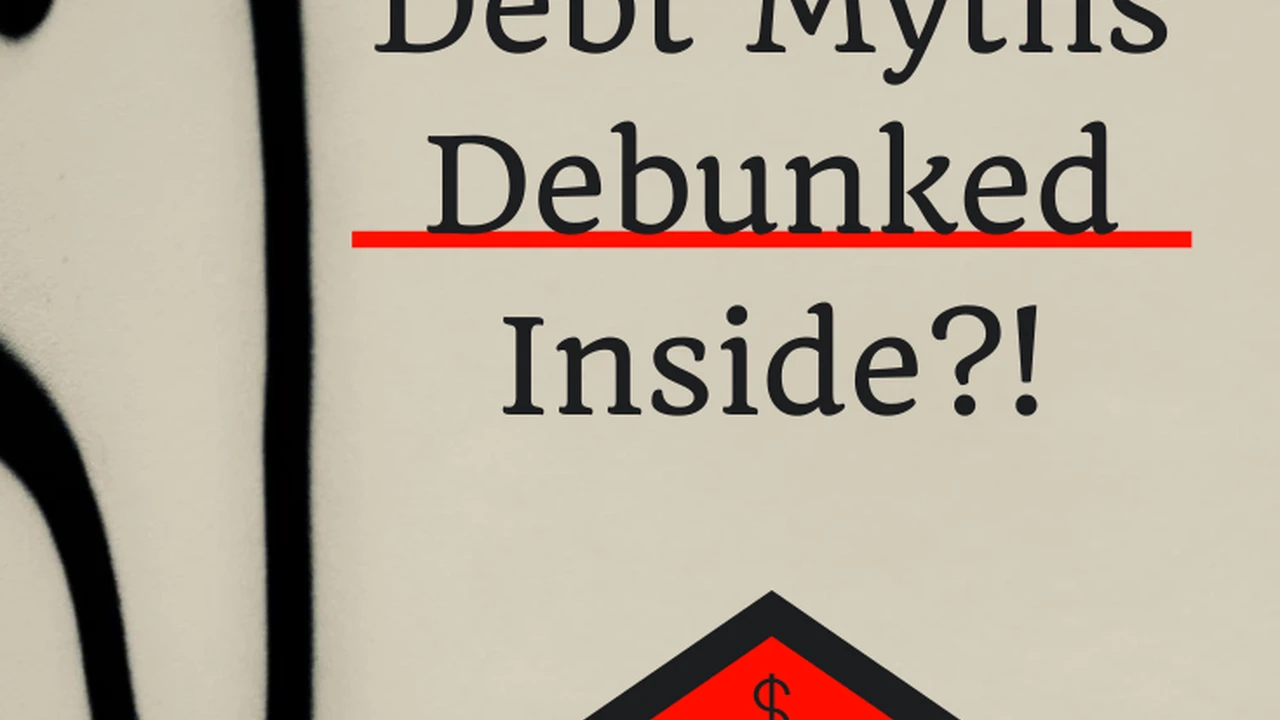7 Common Myths About IRS Tax Debt Relief Debunked
Uncover the truth behind 7 common myths surrounding IRS tax debt relief and make informed decisions about your tax obligations.

7 Common Myths About IRS Tax Debt Relief Debunked
Myth 1 The IRS Will Never Negotiate Tax Debt
This is perhaps one of the most pervasive and damaging myths about the Internal Revenue Service. Many taxpayers, overwhelmed by the prospect of owing money to the government, believe that the IRS is an unyielding entity that will stop at nothing to collect every last penny, regardless of their financial situation. This simply isn't true. While the IRS is indeed a powerful collection agency, its primary goal is to collect the maximum amount of tax revenue efficiently. They understand that sometimes, taxpayers face genuine financial hardship that prevents them from paying their tax debt in full. In such cases, the IRS is often willing to negotiate and offer various relief programs. These programs are designed to help taxpayers resolve their tax debt in a way that is both manageable for them and acceptable to the IRS. Ignoring your tax debt or assuming the IRS won't work with you is the worst possible approach. Proactive communication and understanding the available options are key.
The IRS has several established programs specifically for taxpayers who cannot pay their tax debt in full. These include Offer in Compromise (OIC), Installment Agreements, and Currently Not Collectible (CNC) status. Each program has specific eligibility requirements and offers different levels of relief. For example, an Offer in Compromise allows certain taxpayers to resolve their tax liability with the IRS for a lower amount than what they originally owe. This is typically granted when there's doubt as to collectibility, meaning the IRS believes they won't be able to collect the full amount due to the taxpayer's financial situation. Installment Agreements, on the other hand, allow taxpayers to make monthly payments over a period of up to 72 months. This is a good option for those who can pay their debt but need more time. Finally, Currently Not Collectible status is for taxpayers experiencing severe financial hardship, where paying their tax debt would leave them unable to meet basic living expenses. In this status, the IRS temporarily suspends collection efforts. The crucial takeaway here is that these programs exist, and the IRS is legally obligated to consider them for eligible taxpayers. Don't let the myth of an unnegotiable IRS deter you from seeking help.
Myth 2 Tax Debt Relief is Only for the Rich or Extremely Poor
Another common misconception is that tax debt relief programs are exclusive to either the very wealthy, who can afford expensive tax attorneys, or those in extreme poverty. This myth often discourages middle-income taxpayers from exploring their options, leading them to believe they don't qualify for any assistance. The reality is that IRS tax debt relief programs are designed to be accessible to a wide range of taxpayers, regardless of their income bracket, as long as they meet the specific criteria for each program. Eligibility is primarily based on your financial situation, including your income, expenses, assets, and ability to pay, rather than a strict income threshold.
For instance, an Offer in Compromise (OIC) considers your 'Reasonable Collection Potential' (RCP), which is a calculation of your ability to pay based on your assets and future income. This means that a middle-income individual with significant medical debt or other financial burdens might qualify for an OIC, just as someone with a lower income might. Similarly, Installment Agreements are available to anyone who owes up to $50,000 in combined tax, penalties, and interest (for individuals) or $25,000 (for businesses) and can make monthly payments. The key is demonstrating a legitimate inability to pay the full amount immediately or within a short timeframe. The IRS provides clear guidelines and forms for these programs, and while professional help can be beneficial, it's not a prerequisite for applying. Many taxpayers successfully navigate these processes on their own or with the help of enrolled agents or CPAs who offer more affordable services than high-end tax attorneys. The focus is on your financial circumstances, not your net worth or lack thereof.
Myth 3 You Can Go to Jail for Unpaid Tax Debt
This myth is a significant source of anxiety for many taxpayers facing tax debt. The fear of imprisonment for simply owing money to the IRS is largely unfounded in the vast majority of cases. While tax evasion – intentionally and illegally avoiding paying taxes – can indeed lead to criminal charges and jail time, simply being unable to pay your tax debt is a civil matter, not a criminal one. The IRS is a collection agency, not a law enforcement agency in the traditional sense for civil tax matters. Their primary tools for collecting unpaid taxes are liens, levies, and wage garnishments, not incarceration.
Criminal tax charges, which can result in jail time, are reserved for severe cases of intentional fraud, such as filing false tax returns, hiding income, or deliberately failing to file for multiple years with the intent to deceive the government. These cases are typically investigated by the IRS Criminal Investigation (CI) division and involve a high burden of proof. If you've simply made a mistake on your taxes, underestimated your income, or experienced financial hardship that prevents you from paying, you are highly unlikely to face criminal prosecution. The IRS wants to collect the money you owe, and they understand that putting you in jail would make it impossible for you to earn income and pay your debt. Their focus is on civil remedies to recover the funds. If you're concerned about potential criminal charges, it's crucial to consult with a tax attorney immediately, but for most people with unpaid tax debt, jail time is not a realistic threat.
Myth 4 All Tax Debt Relief Companies Are Scams
The unfortunate truth is that the tax debt relief industry has its share of unscrupulous operators, which has led to the widespread myth that all such companies are scams. While it's vital to be cautious and conduct thorough due diligence, it's equally important to recognize that many legitimate and reputable tax debt relief companies and professionals exist. These legitimate firms employ experienced tax attorneys, enrolled agents, and CPAs who can provide valuable assistance in navigating the complex world of IRS tax resolution. They understand the tax code, the IRS's procedures, and the various relief programs available, and they can advocate on your behalf to achieve the best possible outcome.
The key is to differentiate between legitimate help and fraudulent schemes. Scam companies often make unrealistic promises, such as guaranteeing a specific percentage reduction in your tax debt or claiming they can make your tax debt disappear entirely. They might demand large upfront fees without providing clear explanations of services or a written agreement. Legitimate companies, on the other hand, will offer a realistic assessment of your situation, explain the process clearly, provide transparent fee structures, and have verifiable credentials. They will also emphasize that results are not guaranteed and depend on your specific circumstances. Always check a company's reputation with the Better Business Bureau (BBB), read client reviews, and verify the credentials of the professionals they employ. Don't let the existence of bad actors deter you from seeking professional help if you need it, but be smart and selective in your choice.
Recommended Tax Debt Relief Services and Platforms
When considering professional help, here are a few reputable options that often receive positive reviews and offer a range of services:
- Optima Tax Relief: Known for its comprehensive services, including Offer in Compromise, Installment Agreements, and penalty abatement. They employ tax attorneys, enrolled agents, and CPAs. Optima offers free consultations to assess your situation. Their pricing varies significantly based on the complexity of the case, typically ranging from $2,000 to $10,000+. They are generally well-regarded for their customer service and success rates, though some clients report higher fees.
- Tax Defense Network: Offers a broad spectrum of tax resolution services, including OICs, installment agreements, and audit representation. They have a team of tax professionals and provide free consultations. Their pricing structure is also case-dependent, often in the range of $1,500 to $8,000. They are praised for their responsiveness and ability to handle various tax issues.
- Community Tax: Provides tax resolution, tax preparation, and accounting services. They focus on personalized solutions and have a strong track record with OICs and penalty abatements. Free consultations are available. Their fees are competitive, usually between $1,800 and $9,000, depending on the service and complexity. They are often highlighted for their client-focused approach.
- Jackson Hewitt Tax Resolution Services: A well-known name in tax preparation, Jackson Hewitt also offers tax resolution services. They leverage their extensive network of tax professionals to help with IRS issues. Their services are often more accessible for those who prefer in-person consultations. Pricing can be more modular, with initial fees for assessment and then additional costs for specific resolution services.
- H&R Block Tax Audit & Tax Notice Services: Similar to Jackson Hewitt, H&R Block provides support for audits and tax notices, which can be precursors to tax debt. While not exclusively a 'tax debt relief' company in the same vein as Optima or Community Tax, their services can be crucial in preventing debt from escalating or resolving issues early. Their pricing for these services is typically lower, often starting from a few hundred dollars for basic notice responses.
Comparison Factors: When choosing, consider the following:
- Cost: Get a clear breakdown of all fees upfront.
- Services Offered: Ensure they cover your specific needs (OIC, IA, penalty abatement, audit representation).
- Professional Credentials: Do they employ tax attorneys, EAs, or CPAs?
- Reputation: Check BBB ratings, online reviews, and state bar associations (for attorneys).
- Communication: How responsive and transparent are they?
Myth 5 Filing for Bankruptcy Will Eliminate All Tax Debt
While bankruptcy can provide relief from many types of debt, it's a common and dangerous myth that it automatically wipes out all tax debt. The reality is far more nuanced. Only certain types of tax debt can be discharged in bankruptcy, and strict conditions must be met for this to happen. Generally, older income tax debts are the most likely to be dischargeable, but even then, there are specific rules regarding the age of the tax debt, the filing of tax returns, and the assessment of the tax.
For a federal income tax debt to be dischargeable in bankruptcy, it typically must meet the '3-2-240 Rule':
- The tax return for that debt must have been due at least three years before you filed for bankruptcy (including extensions).
- You must have filed the tax return for that debt at least two years before you filed for bankruptcy.
- The tax must have been assessed by the IRS at least 240 days (8 months) before you filed for bankruptcy.
Additionally, the tax debt must not be the result of fraud or willful evasion. Payroll taxes, trust fund recovery penalties, and property taxes are generally not dischargeable in bankruptcy. If you have a tax lien against your property, bankruptcy might discharge your personal liability for the debt, but the lien itself could remain on your property, meaning the IRS could still seize the property to satisfy the debt. Bankruptcy is a complex legal process, and its impact on tax debt should always be discussed with a qualified bankruptcy attorney who specializes in tax matters. Don't assume it's a magic bullet for all your tax woes.
Myth 6 The IRS Will Never Find Out If I Don't File or Pay
This myth is born out of wishful thinking and a misunderstanding of the IRS's capabilities. In today's digital age, the idea that the IRS won't discover unfiled returns or unpaid taxes is increasingly unrealistic. The IRS has sophisticated data matching systems that cross-reference information from various sources. They receive copies of almost every financial transaction you make that has tax implications. This includes W-2s from employers, 1099s from banks, investment firms, and independent contractors, K-1s from partnerships, and even information from state agencies and foreign financial institutions (thanks to agreements like FATCA).
If you don't file a return, the IRS often has enough information to create a 'substitute for return' (SFR) for you. This SFR typically only includes income, without any deductions or credits you might be entitled to, resulting in a higher tax liability. Once an SFR is processed, the IRS will begin collection actions. If you file but don't pay, the IRS will certainly know. They track all filed returns and payments. While it might take some time, the IRS will eventually catch up. Ignoring your tax obligations only leads to accumulating penalties and interest, and potentially more aggressive collection actions like liens and levies. The IRS has a long memory and significant resources. It's always better to be proactive, file your returns, and address any payment issues head-on rather than hoping to fly under the radar.
Myth 7 Once You Have Tax Debt You're Stuck Forever
This myth is a major source of despair for taxpayers struggling with IRS debt. The idea that tax debt is a life sentence, an inescapable burden that will follow you indefinitely, is simply not true. While tax debt can be persistent and challenging to resolve, there are numerous pathways to resolution, and the IRS does have a 'statute of limitations' on collection. This means there's a time limit within which the IRS can legally collect the taxes you owe.
Generally, the IRS has 10 years from the date the tax was assessed to collect the tax debt. This is known as the Collection Statute Expiration Date (CSED). Once this 10-year period expires, the IRS can no longer legally pursue collection actions for that specific tax debt. However, it's crucial to understand that certain actions can pause or extend this 10-year clock. For example, filing for bankruptcy, requesting an Offer in Compromise, requesting a Collection Due Process hearing, or living outside the U.S. for an extended period can all toll (pause) the statute of limitations. This means the clock stops running during these periods and resumes once the action is resolved. While the CSED provides a potential end date, it's not a strategy to rely on without careful planning and professional advice. Actively working with the IRS through their relief programs is almost always a better and less stressful approach than waiting out the clock, which can lead to severe collection actions in the interim. Tax debt is resolvable, and with the right strategy, you can move past it and regain financial stability.
:max_bytes(150000):strip_icc()/277019-baked-pork-chops-with-cream-of-mushroom-soup-DDMFS-beauty-4x3-BG-7505-5762b731cf30447d9cbbbbbf387beafa.jpg)






